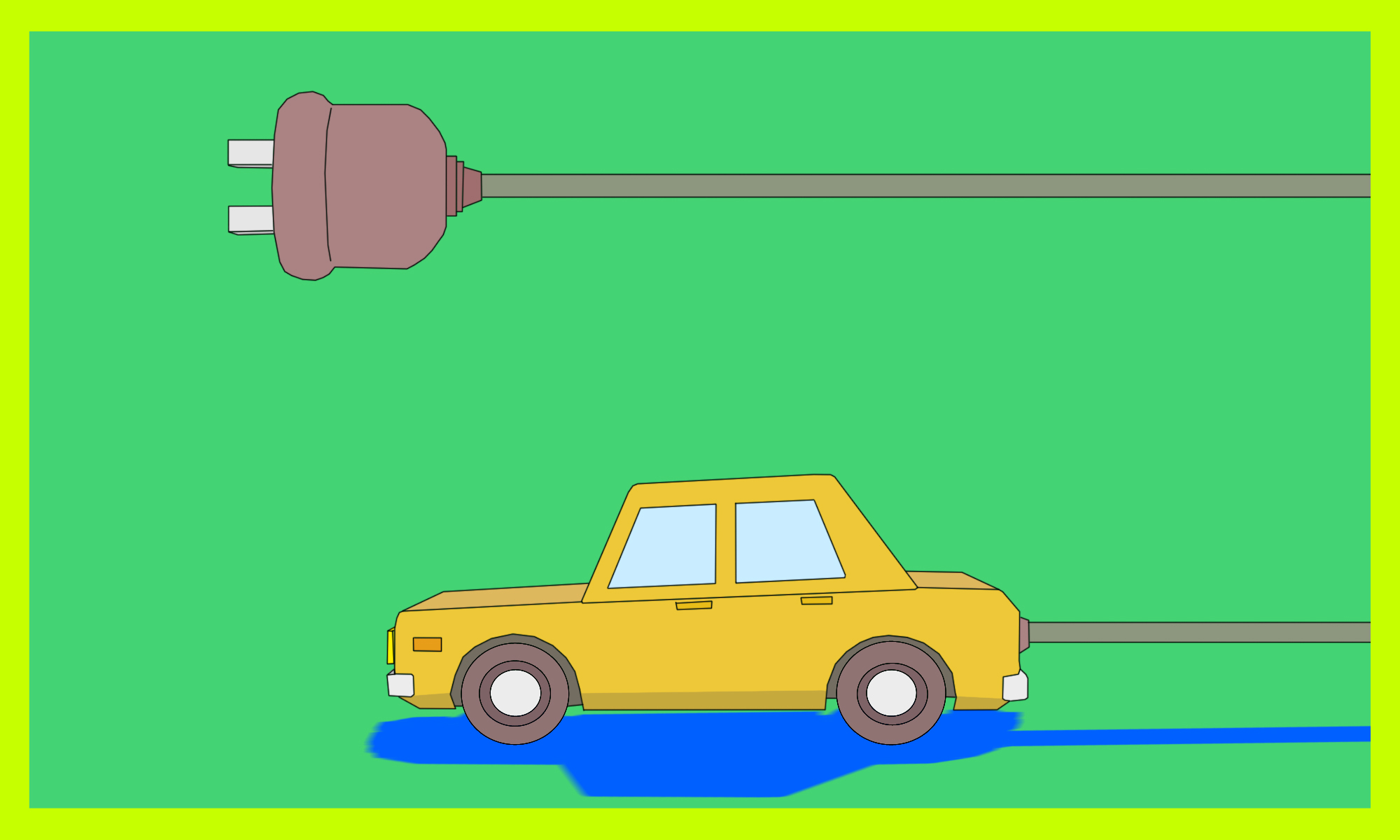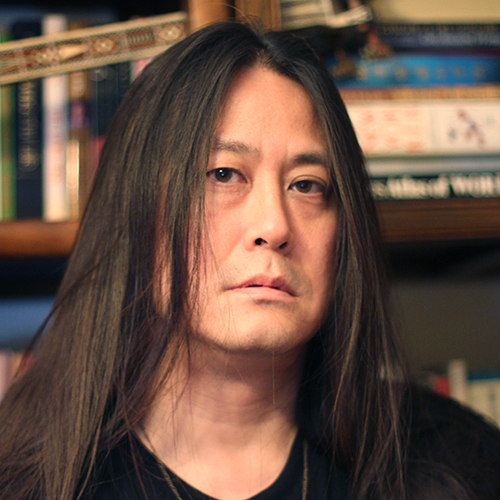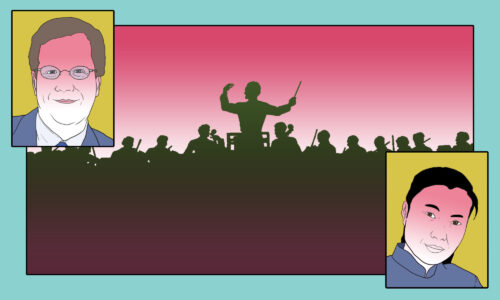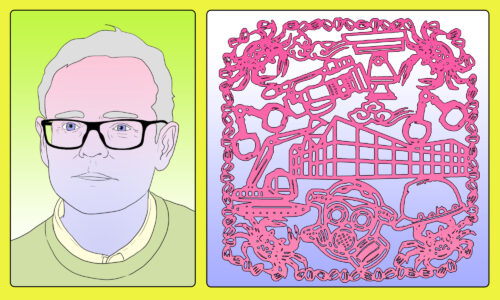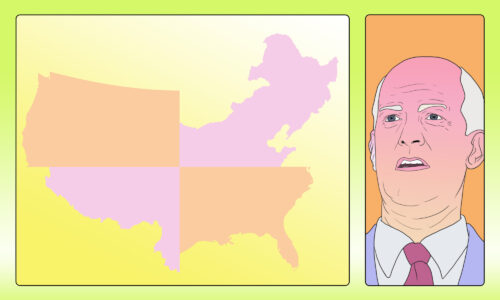Below is a complete transcript of the Sinica Podcast with Henry Sanderson.
Kaiser Kuo: Welcome to the Sinica Podcast, a weekly discussion of current affairs in China, produced in partnership with The China Project. Subscribe to Access from The China Project to get, well, access. Access to, not only our great daily newsletter, but to all of the original writing on our website at thechinaproject.com. We’ve got reported stories, essays and editorials, great explainers and trackers, regular columns, and of course, a growing library of podcasts. We cover everything from China’s fraught foreign relations to its ingenious entrepreneurs, from the ongoing repression of Uyghurs and other Muslim peoples in China’s Xinjiang region, to Beijing’s ambitious plans to shift the Chinese economy onto a post-carbon footing. It’s a feast of business, political, and cultural news about a nation that is reshaping the world. We cover China with neither fear nor favor.
I’m Kaiser Kuo, coming to you from Chapel Hill, North Carolina.
Joining me from the thickets and brambles of storied Goldkorn Holler out there in Middle Tennessee is Jin Yumi, also known as Jeremy Goldkorn, who is taking time away from his balloon and drone launch center that he’s built on his property, where this very afternoon he plans on sending up a fifth craft — this time shaped like a giant alpaca or a grass mud horse, which he’s hoping will be taken down by an F-22. You’ve done pretty well so far. I think you’re four for four. Tell us how many of your vehicles have already been down exactly?
Jeremy Goldkorn: No, none of them. None of them, Kaiser.
Kaiser: Oh, come on.
Jeremy: As somebody from the, I think, the State Department said yesterday, none of these things were extraterrestrial craft. So, that rules mine out.
Kaiser: Right. But do greet the people.
Jeremy: Hello people.
Kaiser: I hope at least they were electric powered.
Jeremy: Absolutely.
Kaiser: Okay. No, that good because since we’re talking all about electric vehicles and the batteries that power them today, we are pleased to be joined by Henry Sanderson, a former reporter for the AP and for Bloomberg who now serves as executive editor for Benchmark Mineral Intelligence, which is a provider of data and analysis for the lithium ion battery supply chain.
Jeremy: Henry worked for many years in China and is a leading expert on electric vehicles and the batteries that power them. He’s the author of the Fantastic 2022 Book, Volt Rush: The Winners and Losers in the Race to Go Green, a book that reminds us of the very ugly fact that the metals that are needed to make electric vehicle batteries need to be dug out of the earth and processed in ways that are anything but environmentally friendly. Henry, I’ve talked to you a few times before, and it’s a delight to welcome you to Sinica.
Henry Sanderson: Thanks for having me.
Kaiser: Yeah, Henry, great to have you on it last.
Henry: Thank you.
Jeremy: Henry, could we start with some numbers? Could you give us a sense of just how big a player China is in the battery and electric vehicle sector? The batteries themselves from the mining of key metals like lithium, cobalt, and nickel, to the processing of these metals, to the actual finished car?
Henry: Yes. Thank you very much for having me, and I look forward to the discussion. So basically, what’s so interesting about what’s going on at the moment is we’re seeing that clean energy and especially EVs are becoming a greater part of geopolitics and national security. And the reason is that China’s had quite a bit of a head-start over the West in terms of clean energy technologies such as solar and batteries. If you look at batteries, where China really dominates is the processing of battery minerals. It’s the production of battery materials and production of the lithium-ion batteries themselves. So, if you look at processing, lithium, it’s about 44% of lithium chemicals, but if you look at things like graphite, which is used in batteries, it could be a almost 100% is processed in China.
And if you look at sort of cathode and anodes, which are materials that go into EV batteries, China’s also very, very dominant and produces almost all of the cathodes and anodes. And batteries, China produces around 70% of lithium-ion batteries. So, China’s really dominant in a lot of these stages. Where it’s not dominant is actually mining the raw materials. China’s not blessed with a lot of deposits of these minerals. So, China has to import raw materials from Australia, from Chile, from Africa, from other countries. In that sense, it’s still vulnerable, in many ways, like it is to imports of oil and gas. So, it’s more the other steps in the supply chain where China dominates.
Kaiser: Henry, supply chains are very much on everyone’s mind these days, especially, the vulnerabilities, as you say, to supply chains, especially here in the U.S. We’ve experienced obvious disruptions that we felt pretty acutely. We now see them both as sources of vulnerabilities, as I said, but also as strategically vital to us. And there ways that we can exert pressure on geopolitical rivals, including to force China. They’ve been weaponized, I think it’s fair to say. In fact, much of what we’ve done with China vis-à-vis the repression of Uyghurs has focused on depriving China of tech inputs related to surveillance through the extensive Entity Listing program through BIS at commerce. And preventing imports of different goods whose supply chains run through Xinjiang in an effort to stop forced labor.
But even bigger than that is, of course, what we’ve done with cutting off sales of advanced semiconductors and the equipment that’s needed to make those. We’ve gone even further now with the Biden administration now having said that it’s not just semiconductors, it’s not just advanced integrated circuits. It’s now green technology and biotechnology that are also areas of strategic competition where we need to sort of stop China’s advance. It’s quite explicitly now said that we need to slow China down. We’re doing that with semiconductors. Will we start doing that with EVs and with batteries? What do you think also of this approach? Do you think that it will be a setback for the global energy transition?
Henry: I think this is the tricky balancing act that the US policy-makers are thinking through at the moment, which is clean energy technologies, solar panels, batteries, yes, they are complicated, but they’re not like semiconductors, they’re not like future of AI, etc. So, what actually is the national security risk of having Chinese solar panels or China batteries? Obviously, there are things like solar inverters that Huawei makes, perhaps U.S. is not so keen on that, but what really is the risk? And also, if the US doesn’t allow Chinese components, Chinese expertise in, you’re right, it risks delaying the energy transition, and we don’t have time, right? This is a policy-driven transition. We need to make this energy transition in unprecedented speed. And the risk is that if you try to cut China off completely that you delay or increase the cost of this energy transition.
And I think the U.S. is trying to think through how to allow Chinese companies to be involved, and also what is the ownership nature of those companies? Are they state-owned? Are they mixed ownership, etc.? But this week we saw a classic example of some of these issues, which is that Ford said it was building a battery plant in Michigan and it is going to license technology from CATL. It could have easily been a joint venture, but I think, because of political concerns, they have to license the technology. And Michigan got the project because the Virginia governor, they were looking at Virginia, but the governor of Virginia said, “I don’t want this project to be a Trojan horse for the CCP, etc.” But what it really shows is it’s fascinating is that we need Chinese expertise to decarbonize, to produce these batteries at the moment because we just haven’t got a lot of the manufacturing expertise that they have.
But yet, at the same time, the U.S., as you said, doesn’t want China involved. This deal sort of shows an awkward sort of compromise. I don’t quite know if it satisfies a lot of U.S. goals, but it’s necessary because we need to sell many more EVs, and the U.S. needs to sell many more EVs. So, it’s a very difficult balancing act.
Kaiser: Indeed, indeed.
Jeremy: Henry, have you followed the new mooted draft legislation in China that might possibly restrict exports of equipment used to manufacture solar panels? It’s not a law yet, but it’s been in discussion for a number of months, I believe.
Henry: Yeah, I saw news about that about possibly restricting some parts of the solar supply chain exports. I think that obviously it could be very difficult for the West. I also I don’t necessarily see it as in China’s interest to start restricting exports because it’s got a dominant market share. If you look at a lot of the Chinese companies, they want to penetrate markets in Europe and America. They want to expand globally. It doesn’t really seem in China’s interest to do this. It would only accelerate the shift that we’re seeing, especially in the U.S. now, where the Inflation Reduction Act is putting billions in terms of competing with China. I don’t really see the interest in China doing that, but you’re right, it is a threat that they could hold over the West.
Jeremy: Yeah. And it’s probably not really in the US’s interest to restrict using CATL technology for American Electric cars. Anyway, let us move on and talk about lithium. Your book tells the story of the contest between a Chilean mining company called SQM and its former chairman Julio Ponce Lerou, I don’t know if I’m pronouncing that correctly.
Kaiser: Ponce Lerou, I think.
Jeremy: Ponce? He’s a Ponce. Ponce Lerou, who was Augusto Pinochet’s son-in-law, and got together with a Chinese company called Tianqi Lithium. Can you give our listeners the broad stroke outline of that contest and tell us where it stands today, and perhaps how important Chile and SQM are to global lithium production?
Henry: Yeah, it’s a really fascinating story. As I said at the beginning, China does have some lithium resources, but they’re not of the quality of those overseas. What we’ve really seen is China having to go out to the world to secure raw materials, and they’ve done that quite advance of the West, right? So, quite a few years before Western companies really started making deals. And one of the key places that supplied Lithium to China was Chile, started in the late 1990s, actually undercut a lot of other producers because it was so cheap. The lithium in Chile is extracted using the sunlight in the Atacama Desert. So, it’s free energy, right? It’s free power. So, it’s very low CO2 and very cheap as well. SQM is one of the biggest producers in Chile.
And it has this controversial history because it came out of the privatizations that happened under Pinochet. And Pinochet’s son-in-law was, for many years, the leader of the company. What’s so interesting is a few years ago is this Chinese lithium company, Tianqi Lithium, which has been very entrepreneurial, it not only bought a stake in the best lithium mine in the world in Australia, but it decided to buy a stake in SQM of Chile. This was a few years ago, so it was before a lot of the West had sort of woken up to this issue. And I guess what was so interesting was that it showed Chile’s attitude to Chinese investments. And actually we’ve seen a huge amount of Chinese investment in Chile, like the electricity grid, a lot of Chinese investment in Chile is electricity grid, for example.
And there’s a lot of BYD buses in Chile. And the Chilean authorities approved this deal, even though Tianqi is a competitor of SQM. It was kind of an interesting deal to go through, but it really highlighted China’s need and determination to secure lithium resources. Because put it this way, China’s building this mega big battery industry, electric vehicle industry, but without lithium, it’s nothing, right? It’s extremely vulnerable to external supplies of raw materials. So, this is why you saw deals like this, and they paid a huge amount of money for a stake that’s not a controlling stake. They have a member on the board but it’s not a controlling stake. So, it was seen at the time as overpaying, but I think strategically, look, they now own a stake in a big low cost, low-carbon lithium producer. In hindsight, it looks like a pretty good deal.
Kaiser: Where else are they right now? So you said they bought a big stake in Australian lithium producer and in Chile now. Where else around the world are Chinese companies investing in raw lithium resources?
Henry: So, you’ve seen a lot of investment going to Argentina, huge amount of investment going into Argentina. You’ve seen investment going into Africa. A lot of the lithium projects in Africa being developed now, owned or invested in by Chinese — Zimbabwe, DRC, etc. We’ve really seen Chinese companies being very quick footed and aggressive. I think one of the really interesting things about the geopolitics is, as I said, Chile and Argentina, they’re not really that opposed to Chinese investment. In a way, China’s been quite successful in winning these countries over to their side, so to put. Argentina’s signed up to the Belt and Road last year. Chile’s a member of Belt and Road, China’s their biggest trade partner. And we don’t see Chile and Argentina participating in US-led initiatives such as the mineral security partnership, which is an initiative by the U.S. and Europe and others. We don’t see Chile and Argentina getting involved. So, it’s quite interesting geopolitically that these two countries are quite open to Chinese investment.
Kaiser: Henry, just now you mentioned in passing the DRC, the Democratic Republic of Congo. You devote a lot of your book to cobalt. I mean, we all think of lithium-ion batteries as being primarily lithium, but, of course, cobalt, nickel, as you said, graphite, all really important components of it as well.
Henry: That’s right.
Kaiser: It seems like an awful choice when it comes to cobalt between working with, on the one hand, this Swiss-based multinational Glencore and its, well, let us say, highly problematic partner there in the DRC, Dan Gertler, who has been sanctioned by the U.S. under the Global Magnitsky Act. And on the other hand, working with Chinese brokers who often buy from the so-called artisanal miners that you do such a good job of talking about in the book, which really means, I mean, artisanal miners is a very nice euphemism for, of course, these dangerous small-scale operations that often employ child labor. So, what’s a battery company to do? It seems like it’s a choice of evils when it comes to the DRC.
Henry: Yeah, I think that’s one of the interesting things I wanted to open people’s eyes to, and other books have also looked at this, which is that, as the transition to electric vehicles gain pace, people realized, “wait a second, DRC produces 70% of cobalt. You’re not going to have this EV transition without the DRC.” And you’re exactly right, what automakers and others face in the DRC is quite an unenviable choice or was an unenviable choice between cobalt that’s mined by hand, as you said, in mines where they don’t have safety equipment. There’s often deep tunnels, there’s often… You kind of have children getting involved. There’s obviously regular deaths and injuries. And that cobalt gets sold to Chinese traders and eventually ends up in China. Or you’ve got these big mining companies such as Glencore, the biggest cobalt producer such as China Molybdenum is another Hong Kong listed Chinese company.
So, it is a choice of these two things. And what happened initially a few years ago was Amnesty put out a report about the child labor conditions, and I think the auto industry instinctively and initially just wanted nothing to do with the DRC and tried to avoid the country. And Tesla signed a deal with Glencore because their mine is sort of behind big fences. It’s sort of secured, etc. But now we’ve seen a bit of a change where I think auto companies, others, as you saw Microsoft recently called for more engagement in the DRC and trying to sort of semi-formalize these artisanal mining areas. So, provide them some equipment, prevent children going in, etc. But it really is a quite a big task, right? There are lots of these people mining. There’s lots of different areas.
If you fence in one area, they might go to another area. And what sort of standard are we willing to take? I think it sort of brings up a fundamental issue about our engagement with countries like the DRC, which is, I don’t think we should run away, but also we need to accept that it won’t be perfect, the solutions won’t be perfect, but we need to have some nuance in saying that, “yes, we will buy cobalt from the DRC, and we’ll support some of these improvements even though it may not be perfect,” but we need to open our eyes to what’s happening. I think before the electric vehicle, if you talk about our smartphones, all of which have cobalt in, etc., and no one’s cared, right? And the supply chains have been invisible. Whereas now, they’re front and center and people are trying to, trying to improve the situation.
Just a final point, which is the DRC government is also trying to improve the situation. And what they also want is for these guys to get a fairer price. Because at the moment, the Chinese traders, and I’ve seen it myself, they weigh the cobalt that’s given to them. And people don’t trust the price they’re getting. So, DRC government’s keen for them to get a fairer price. Yes, this is all part of the electric vehicle supply chain.
Jeremy: And it is an extraordinary illustration of contemporary inequality, isn’t it? Because the people who run the companies that make their electric cars and the batteries and the phones are the world’s richest people. They’re the bajillionaires. And the people mining the cobalt are some of the world’s most miserable people right now.
Kaiser: Yeah, yeah, yeah.
Henry: That’s exactly right. Yeah. It’s a stark indication of the inequality of our supply chains. And I think the problem also for the DRC is it doesn’t get a lot of the value add from the cobalt. So, as I said, it gets exported to China where it’s processed and turned into battery materials. So, if you think about where the value’s going, China takes a lot of the value of that material. The DRC wants to build more of a supply chain in the country. It’s an interesting country. They’ve got lots of hydropower, they’ve got a young population, so has a lot going for it, but we need to engage with the DRC, and I hope we’ll see more investment there as well.
Kaiser: So, Henry, it struck me that one lesson that somebody might take away from your book is that activism actually works. The NGOs you mentioned just now, the Amnesty report, which was really revelatory, shining a light on the abuses of some of these companies, and here I want to focus on the know the Chinese companies, it actually seems to produce results at the very least. They recognize that they’re going to be punished in the market if they don’t improve their practices when it comes to the mining. Was that one of the lessons that you hoped to impart? And what would be some of the primary examples from your book of Chinese actors who have been chastened and have cleaned up their act, at least to some extent after NGOs pushed them really hard?
Henry: Yeah, I think this is a key point, which is that you’re right, the size of the markets in the U.S. and Europe, we have big leverage when it comes to this supply chain. And if you think about the regulations, the EU is drawing up around batteries and raw materials, this huge leverage, because you’re exactly right. After Amnesty put out this report, Huayou Cobalt, which is a massive Chinese company was named in the report, it really did try to respond and publicly engage and be a bit more open. And I think it was scared and other Chinese companies were scared about losing out on the market opportunity. And we’ve seen this in other areas of the supply chain too. So, that’s really helped engagement, I guess.
But the problem is that we also need to see change on the ground, right? What we need to avoid is just greenwashing or public relations, right? We need to see change on the ground. And that’s why NGOs and others, the work they do is so critically important because they can hopefully go to the ground, check what’s going on and see how things have changed, and consumers as well. And what we’re seeing now is Tesla going to the DRC, as I said, Microsoft I think recently visited there. We’re seeing consumers take more responsibility for visiting and checking conditions on the ground. And you’re right, that’s the power that we have in the West. And we are seeing this also in the EU with Carbon Border Adjustment, with other policies, right? Huge leverage over the Chinese supply chain.
Just finally, Chinese supply chain is also cleaning up, because domestically, as you know, Xi Jinping is putting more pressure on cleaning up the environment. So, they’re facing these issues at home as well.
Kaiser: Great. Great.
Jeremy: Cobalt isn’t the only problematic metal. Even though it’s quite abundant, nickel turns out to be quite hard to extract. And the whole process imposes very high social costs. Can you talk about the problem of nickel, Henry, and what China’s done in Indonesia with nickel mining and processing?
Henry: Yeah, so it’s really interesting. In my book, I hope to give an idea of these new countries that are emerging as powerful in this post or this energy transition, right? As we move from fossil fuels to clean energy, it’s interesting to see which countries are becoming more influential. And DRC, we mentioned, but Indonesia is so important now to the energy transition. And I think it’s gaining a lot of geopolitical clout because most of the nickel for this decade is going to come from Indonesia. So, we can’t really, again, transition to EVs without countries like Indonesia. It also happens to be a big coal producer and relies on coal for its power. But what the Chinese have done in Indonesia is fascinating because they’ve invested about $15 billion in building nickel processing in the country.
These are big industrial parks with their own ports, with their own hotels, runways. And what they do is take the country’s nickel and process that into materials for batteries, for electric vehicles as well as for stainless steel. And the reason is, is that Indonesia’s government, a few years ago, banned exports of raw nickel. So, they were saying, “if you want our nickel, you got to come to the country and invest, and give us jobs,” and all that. So, it was a really interesting example by a developing country of leveraging their resources to build out supply chain. What you have now is a huge investment by the Chinese. They’ve managed to build these plants at ultrafast speed. So, a lot of the nickel is going to come from Indonesia, but the downside is the pollution this cause to local areas, also some of the worker issues, the way they treat local workers, and also the fact that, as I say, Indonesia relies on coal-fired power for electricity.
So, you’ve basically shifted a whole load of industry out of China to Indonesia, but you may have increased the carbon emissions. And that’s so important. Just to give this all in perspective, when you buy your EV, I don’t know if you guys have an EV, producing it takes more carbon emissions to produce than internal combustion engines. So, we need to bring down the carbon emissions of building the battery. That’s why Indonesia is so problematic, right? Because we need to scale up EVs to such a scale that they make a difference but we can’t have all these carbon emissions in the supply chain.
Kaiser: Right.
Jeremy: That’s one of the favorite talking points of the anti-electric car people in the part of America where I live.
Henry: Yeah.
Kaiser: Right. But I mean, I think, just to be clear, this is not what Henry’s book is arguing at all.
Henry: No, no.
Jeremy: No, no, no, no, no, no.
Henry: Because it’s all like room for improvement, right? And as soon as you drive your EV, I mean, not only you cut air pollution, which kills millions every year, but the more you drive, if you charge it with clean energy, then you obviously, you’re paying back some of the CO2 used to produce it, and it’s all about improving, right? So, these supply chains are getting better, the grids are getting cleaner. So, the direction of travel is important.
Jeremy: And you have also pointed out to me before, Henry, that the type of EV you buy does also make a difference. If people carry on buying enormous pickup trucks, that’s obviously going to be less good for the environment than if you buy a small Nissan Leaf.
Henry: Yep.
Kaiser: May I point out that you are the owner of a large pickup truck, Jeremy?
Jeremy: The ex-owner actually.
Kaiser: Oh, you sold it.
Henry: Yeah. Well, this is the interesting thing, right? When you see Biden sitting in an EV, it’s always some monstrous electric SUV or truck, right? Whereas I think if you look at China’s market, there’s many more smaller EVs, right? The Hong Guang Mini is one of the best-selling EVs. So, I think India as well probably will go for smaller EVs. So, I think you’re right, the choices the U.S. makes, the choices Europe makes, have a huge impact on the planet, right? And how many raw materials we need. If you have a smaller battery pack, you can reduce the forecast lithium deficit, for example. Yeah, consumer choice does play a powerful role, right? Are we just going to go out and buy the same size vehicles in EVs, or are we going to use it as an opportunity to think about the whole system?
Kaiser: To get back to these problematic metals for one second, I think, interestingly, the pioneering work in cobalt and nickel-free battery solutions seems to be coming from China.
Henry: Yes.
Kaiser: Can you talk about what BYD is doing in LFP or lithium-ion phosphate batteries, and what are their shortcomings? And what about sodium-ion batteries, which is another potential area?
Henry: Yeah. It’s really interesting. If you talk about the problems I’ve raised in my book, there are solutions. And this is what we need to stress all the time is that innovation and solutions can always be found, and we shouldn’t be too downhearted. LFP, it’s one of those innovations. It’s not a new chemistry. It was actually invented in North America. If you think back to, there was a company called A123 Systems in America after the financial crisis, which listed on the stock market and there was a lot of excitement. It was trying to produce LFP, but it went bankrupt. But China really has taken this LFP chemistry and run with it.
And not only does it produce over 90% of the LFP batteries and battery materials, companies like BYD, they’ve used LFP for a long time, and they’ve managed to engineer it so that you can increase the energy density, which means you can increase the range of the vehicle. Just to say, this chemistry is safer than the nickel and cobalt batteries. It’s longer cycle life and it’s much cheaper. And cheap is everything, right? Cost is everything because we need to get electric vehicles down to the price of internal combustion vehicles. So, China’s done a very good job of producing these cheaper battery chemistries and improving the energy that they can store. That’s exactly why we get to a situation today where Ford is asking CATL, “Can you come to America and teach us how to make these LFP batteries?” Which were actually invented in North America.
That’s the situation, right? China has total expertise now in producing LFP batteries and LFP battery materials. And not only that, sodium ion, as you mentioned, is another technology where China’s rapidly moving ahead to commercialize it, build up the supply chain. Because new technologies, to solve the climate crisis, it’s not just a matter of inventing it in the lab. You need to build the supply chain. And this is what China’s doing for sodium ion. And sodium ion is great because there’s no lithium. Sodium’s abundant. It’s salt basically, right? Again, we have to see what improvements can be made to increase the energy density because sodium ion doesn’t have a high energy density, so it’s unlikely to power you driving 500 miles, right? But what can it do? That’s the question. That’s what we have to see.
Jeremy: So, speaking of batteries, Henry, you gave a great overview of a company we’ve already talked about, CATL, which is, I suppose, the most important battery company in the world, the biggest battery company in the world, I think. Could you talk about that company for the Sinica audience and tell us about its remarkable rise to dominance?
Henry: Yeah.. So, I think CATL is a, is a fascinating story. And it’s just a number of these Chinese companies, as I’m sure you’re aware, are very entrepreneurial, very fast moving, and also have generated tons of billionaires, right? If you look at the billionaires in China, a lot of them are from the green energy sector, CATL is right at the top. It’s an extraordinary story of a company that began producing batteries for mobile electronics in the late nineties, early 2000s in southern China. BYD also started as making batteries for mobile electronics. And this was an industry that shifted from Japan to China at that time. We all know the reasons, right? Lower labor costs, lower environmental standards, etc.
But CATL moved from that beginning to producing electric vehicle batteries. And it got its start just at the time when the Chinese government was starting to really subsidize the electric vehicle industry. So, 2011, that sort of time period, post the financial crisis, and it really could see what was coming, what the Chinese government wanted to do. It was interesting that BMW in China was one of its first customers. And BMW really helped CATL develop its batteries. But it just grew so rapidly, invested so heavily to today where you get a situation where it’s almost too big, right? It supplies so many automotive companies and also a lot of the Chinese startups. And what we’re now seeing is, interestingly, that it’s investing in more Chinese electric vehicle startups.
It has a project with Huawei, EV project with Huawei, and it also contributed to financing this last week of Zeekr, which is a brand by Geely. So, CATL has really got its tentacles in, in all areas of this industry, and it’s just so, so big, right? It’s got a plant in Germany, in the heart of Germany’s auto industry. It’s going to build a plant in Hungary, the biggest FDI in Hungary’s history. And as I said, it’s going to build this plant with Ford as well in Michigan. So, you’ve ended up in a situation where the entire auto industry is, in a lot of ways, reliant on this Chinese company.
Jeremy: CATL perhaps is the most famous, or perhaps most dominant, but Chinese-owned companies generally have come to dominate just about the mining of the metals needed, but certainly the downstream processing and production of key metals and of the batteries themselves. How much of that is due to deliberate policies of the Chinese state and how much is basically the enterprises and the entrepreneurs themselves, which happen to be Chinese? And is that even a useful distinction?
Henry: I think a lot of it is to do with the entrepreneurs, the people themselves. I think the idea that there’s somehow this like amazing vision and they just push a button and it all happens, yes, the policy direction was clear and the subsidies were there to stimulate the market. But really, it’s been a lot of entrepreneurs that have gone out and expanded rapidly and being quite brave and quite gutsy. As I said earlier, Tianqi Lithium buying this Australian lithium mine, investing in Chile. Huayou Cobalt just went to the Democratic Republic of Congo. Just went there to try and secure cobalt. CATL as we’ve talked about, but there’s loads of others who’ve been quite entrepreneurial, moved really fast and managed to, I guess, get lots of financing to expand capacity.
And if you look at clean energy more generally, I mean, the reason the cost of solar has come down, the reason the cost of batteries have come down is because China has invested so much in capacity, right? And in expanding capacity. Now there are some downsides to that. You can get over capacity, and obviously we saw in solar, it was quite a brutal shakeout with a lot of companies going bankrupt. And the EV industry in China is now super competitive. I think there’s going to be at least a hundred new electric vehicle models this year being launched. So, it is super competitive. But what I think is the policy has been clear. We’re seeing that in the U.S. now with the Inflation Reduction Act, but obviously people worry it could change if administrations change, right?
Whereas I think China, the policy has been clear, the subsidies have been clear, and the financing has got behind the industry, right? We’ve seen a lot of big financings have been done. The capital’s got behind the industry.
Jeremy: I mean, if I was to summarize that answer, I would say your point of view is that it is the entrepreneurs and the enterprises that have really pushed China ahead, but they’ve done so with the support, financial and otherwise, of the government.
Henry: I think, yeah, it’s an interesting point because we are seeing with the Inflation Reduction Act in the U.S. very much the same philosophy, which is you set out a clear policy, you provide lots of generous subsidies, but the government dollars can’t do it all, right? You need the private sector to go in and realize the policy direction to be catalyzed by government investment and to jump on the bandwagon. That’s what happened in China, really. It’s interesting because the U.S., and Europe as well, they’re now looking at to learn a lot about industrial policy, right? And industrial policy is in vogue at the moment. But the interesting thing that I think, as I said about China, is not just a state-directed, state-owned thing.
It’s been quite entrepreneurial and a lot of private entrepreneurs. I think what we are seeing, though, is there are companies which have mixed ownership. This is a thing that’s emerged in China, right? Where you may have a local SOE owning a stake in the company, so it’s not completely state-owned, but it has some state backing or backing by state funds, etc. So, yes, the state’s not completely absent but you have seen a lot of private capital as well.
Kaiser: Henry, just now you talked about how the Europeans and the Americans are looking to learn about industrial policy. But in the later chapters of your book, you talk about how the Europeans have made pretty considerable progress toward creating their own domestic battery industry. What lessons should we be learning from them? What should the U.S. be looking at? What have they done right? And what could we pick up on?
Henry: Yeah, it’s a good question. I think now the Europeans are looking at the U.S., and thinking, “holy (bleep), we need to step up a gear.” But you’re right, we did see an example in Europe, a company called Northvolt, I write about, in Sweden, where it’s a really interesting story, where from nothing, they created a battery company to challenge Asia’s dominance, to challenge China’s dominance. And I think a lot of the lessons we saw from that were they did get government support, European Investment Bank, others like that supporting it, but they also had good engagement from customers and big car companies like Volkswagen, etc. They had a lot of support from all the people that mattered. And I think, for sure, the European help they got was critically important.
Everyone sort of got behind them and was quite unified in supporting them. But it’s still quite early days because they only started production, I think it was last year. So, we still have to see how it’s going to develop, but I think Europe was just so keen to have its own battery producer that it had to succeed. But interestingly, UK was also keen, and we’ve seen a failure. A company called Britishvolt went bankrupt recently. So, a lot of people are looking at the lessons from that and what happened with North Vault. And I think one of the key reasons is getting big customers on board to support your industry. And this is what CATL did with BMW, right? Getting your clients on board early as well as government policy is really important.
Kaiser: Yeah, yeah. Yeah, absolutely.
Jeremy: Henry, we’ve touched on this a little already, but let me ask it in one explicit question. What should a consumer think about when they think about electric cars if you want to be an ethical user of motorized transport? And perhaps everyone should just ride bicycles, but if you want to use motorized transport, what should you think about?
Henry: Yeah. You should think good things, right? I think EVs are great. I have an EV. What’s so important when you get one is to realize it’s a better product. I think people used to think we had to sacrifice something to decarbonize. And I think what’s interesting is it’s actually a better product. It drives much better, accelerates much better. And supply chain issues, I think for the consumer should be, “do we need to buy electric SUVs, big electric pickups, etc.?” But also, you could look at where the companies are sourcing their batteries and materials, how much information they give. You can look at whether they transparent about the carbon emissions of producing their vehicle.
We’ve seen some companies be quite transparent about it, like Polestar, for example. Those are all things to look at, right? And obviously, cost is going to matter a lot, right? And, and I think the interesting thing to see about China, you know, China’s exporting more electric vehicles overseas than ever before. I think it surpassed Germany in terms of total auto exports last year. What we have to see now in the West is, what’s the Western consumer going to feel towards Chinese brand EVs? I was speaking to someone who’s done some surveys, and it seems that Western consumers are quite happy to buy Chinese EVs, they’re lower cost, etc. They don’t necessarily think about the brand connotations, but obviously that could change as the political situation changes.
But in Europe, we’re going to see really soon, how consumers feel about Chinese EVs. And to your question, they should also ask questions about where the battery comes from and materials come from. We need to need to keep up on the transparency. And we need to, yeah, be aware of greenwashing as well.
Kaiser: LFP, baby, all the way. That’s what I’m doing.
Henry: Yeah.
Kaiser: Jeremy mentioned just sort of flippantly, but I think he’s right that maybe we should all ride bicycles. We ran an op-ed recently from Debbie Seligsohn that argues, I think very, very convincingly, that for much of the developing world, it’s not electric cars that are going to make the most difference in the energy transition, but rather the combination of electrified subways and electric two-wheelers, especially for that last mile. I mean, implicit in her argument is that we, in the developed world, in the global north, we tend to focus too much on four-wheeled vehicles. And we are ignoring a huge space that China will inevitably rush in to fill. What do you think of the opportunity in electric two-wheelers and whether the U.S. or Europe should contest that space in some way?
Henry: Yeah, so it’s a really good point. I’d like to read that op-ed. In India, the opportunity’s huge, right? And we’re seeing some pretty rosy forecasts by, there’s a company called Ola Electric, one of the companies in India producing electric two-wheelers. I think the CEO said the other day that he thinks all two-, three-wheelers in India could be electric by 2025, I think, or within the next few years. So, there’s huge potential in India to electrify two-, three-wheelers. Obviously, Southeast Asia, other countries as well. Yeah, when we think of electrifying transport, we have got to think of everything, right? And not just cars: scooters, boats, other things. One of the interesting things about the energy transition is the multitude of applications and probably the multitude of solutions, right?
Might not be batteries for everything. It might be hydrogen for trucking, etc. But I think it’s a really good point that we think a lot in the West about, yeah, four-wheel cars, whereas it is a different situation elsewhere. But of course, these are much smaller batteries, so it’s much better from a raw material point of view. But still the batteries need to be produced. We need to see investment in this sector. And I think what we’re seeing in India is the government wants to stimulate domestic battery production. But at the moment, it’s Chinese batteries that are being used in India.
Kaiser: Well, Henry Sanderson, thank you so much for making the time to talk to us, and once again, the book is called Volt Rush: The Winners and Losers in the Race to Go Green. It is just a terrific read. Pick up a copy today. I can’t recommend it more highly. It’s really readable, full of great anecdotes. There’s political drama in there. There’s just all sorts of crazy characters and some reporting from all over the world. I mean, Henry, it was an amazing book.
Henry: Thank you.
Kaiser: Congratulations on it. I know that it’s gotten quite a bit of critical acclaim and it’s all very well deserved. Let’s move on now to recommendations, but first Jeremy, tell us what the listeners can do to support the work that we do here at the Sinica Podcast.
Jeremy: Absolutely. So, Sinica remains free, but if you subscribe to Access, you get an early ad-free version of the podcast every Monday. And you also get a daily newsletter that runs up all the most important news from China every weekday, and access to all of the content on our website.
Kaiser: Yeah. So, I think we’re running a special still right now. It’s just a dollar to become an Access member for your first month. And so, what do you have to lose? Check it out. It’s fantastic. And Jeremy, you always put the free Monday podcast or the ad-free Monday podcast first, but really it’s the newsletter that is the great value here, right?
Jeremy: Well, yeah, thank you.
Kaiser: You work very hard on that thing. I know. I mean, I always see you just working up until the end of the day, so, fantastic. All right. Let’s go on to recommendations now. Jeremy, you always start. What do you have for us?
Jeremy: I just, I guess, especially aimed at American readers who might like or know the New York Review of Books. It had a child in London called the London Review of Books, which I believe is now independent. And I started reading it and somehow it’s much better than the New York Review of Books. So, I’m recommending the London Review of Books.
Kaiser: No, it’s great. I mean, I didn’t know that the two had ever been in a relationship or that there was sort of a father-
Jeremy: It’s complicated.
Kaiser: Yeah. Apparently, it’s complicated. Great. Okay, great. Henry, what do you have for us?
Henry: Yeah. I’ve been reading, I’m sure you know about the book, The Impossible City, a Hong Kong memoir by Karen Cheung, which I find it’s quite nostalgic because I actually spent a lot of my younger years in Hong Kong. So, it’s quite nostalgic for me reading certain parts of that book. But yeah, I recommend that.
Kaiser: Great. The Impossible City.
Jeremy: Nice.
Kaiser: I want to recommend the newsletter, Tracking the People’s Daily, from the amazing Manoj Kewalramani, who was a guest on the show about a year ago talking about India and China in the Ukraine War dilemma. Great guy. He publishes this newsletter that just goes through and translates everything of-
Henry: Yeah, super useful. Super useful. I really like him.
Kaiser: Oh my God. Yeah, it’s so good. Yeah, it saves me so much headache. If you’re like me and you don’t really derive a lot of enjoyment from reading turgid party prose — No, I mean, seriously, it’s a fantastic service that he’s doing. And it’s increasingly important for us to understand what the Chinese leadership is thinking. Yeah, I highly recommend you sign up for that newsletter. It’s called Tracking the People’s Daily. All right, Jeremy. Hey, thanks so much man. It was good to see you.
Jeremy: Yeah, good. And thank you so much, Henry. It was great to see you again.
Henry: Thank you. Thanks so much, guys. I really enjoyed it.
Kaiser: Yeah. The Sinica Podcast is powered by the China Project and is a proud part of the Sinica Network. Our show is produced and edited by me, Kaiser Kuo. We would be delighted if you would drop us an email at sinica@thechinaproject.com or just give us a rating and a review on Apple Podcast as this really does help people discover the show. Meanwhile, follow us on Twitter or on Facebook at @thechinaproj, and be sure to check out all the shows in the Sinica Network. Thanks for listening, and we’ll see you next week. Take care.
